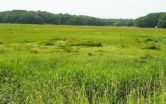(Press-News.org) WOODS HOLE, Mass.—Salt marshes have been disintegrating and dying over the past two decades along the U.S. Eastern seaboard and other highly developed coastlines, without anyone fully understanding why. This week in the journal Nature, MBL Ecosystems Center scientist Linda Deegan and colleagues report that nutrients—such as nitrogen and phosphorus from septic and sewer systems and lawn fertilizers—can cause salt-marsh loss.
"Salt marshes are a critical interface between the land and sea," Deegan says. "They provide habitat for fish, birds, and shellfish; protect coastal cities from storms; and they take nutrients out of the water coming from upland areas, which protects coastal bays from over-pollution." Losses of healthy salt marsh have accelerated in recent decades, with some losses caused by sea-level rise and development.
"This is the first study to show that nutrient enrichment can be a driver of salt-marsh loss, as well," says David S. Johnson of the MBL, a member of the team since the project began in 2003.
This conclusion, which surprised the scientists, emerged from a long-term, large-scale study of salt marsh landscapes in an undeveloped coastline section of the Plum Island Estuary in Massachusetts. Over nine years, the scientists added nitrogen and phosphorus to the tidal water flushing through the marsh's creeks at levels typical of nutrient enrichment in densely developed areas, such as Cape Cod, Mass., and Long Island, N.Y. (Usually, nutrients originating from septic systems, sewerage, and soil fertilizers on land flow with rainwater down to the coastal ocean.)
A few years after the experiment began, wide cracks began forming in the grassy banks of the tidal creeks, which eventually slumped down and collapsed into the muddy creek. "The long-term effect is conversion of a vegetated marsh into a mudflat, which is a much less productive ecosystem and does not provide the same benefits to humans or habitat for fish and wildlife," Deegan says.
Until this study, it seemed that salt marshes had unlimited capacity for nutrient removal, with no harmful effects on the marshes themselves. "Now we really understand that there are limits to what salt marshes can do," Deegan says. "And in many places along the Eastern seaboard—such as Jamaica Bay in New York, where marshes have been falling apart for years—we have exceeded those limits."
The disintegration of the nutrient-enriched marsh in this study happened in several stages, the scientists report. In the first few years, the nutrients caused the marsh grass (primarily cordgrass Spartina spp.) along the creek edges to get greener and grow taller, "just like when you add fertilizer to your garden," Deegan says. This taller grass also, however, produced fewer roots and rhizomes, which normally help stabilize the edge of the marsh creek. The added nutrients also boosted microbial decomposition of leaves, stems, and other biomass in the marsh peat, which further destabilized the creek banks. Eventually, the poorly rooted grass grew too tall and fell over, where the twice-daily tides tugged and pulled it. The weakened creek bank then cracked and fell into the creek.
By year six of the experiment, the scientists started seeing impacts at higher marsh elevations, above the lower creek banks. Three times more cracks, and bigger cracks, emerged at the top of the banks parallel to the creeks, than in a control marsh where no nutrients were added. Eventually, parts of the higher marsh also broke off and slid down toward the creek (which the scientists call the 'toupee effect,' because it leaves behind patches of bare, unvegetated mud). All told, at least 2.5 times more chunks of marsh fell into the creeks in the nutrient-enriched marsh than in the control system.
"We honestly did not anticipate the changes we measured," says Deegan. "Based on prior small-scale experiments, we predicted nutrient enrichment would cause the marsh grass to grow better and remain stable. But when we allowed different parts of the ecosystem to interact with the nitrogen enrichment over time, the small process changes we saw in the first few years resulted in the creek banks later falling apart. This could not have been extrapolated from the smaller-scale, shorter term studies."
Nutrient enrichment of coastal areas is known to cause harmful algae blooms, which create low-oxygen conditions that kill off marine life. "Now we understand that nutrient enrichment also causes a very important loss of salt marsh habitat for fish and shellfish," Deegan says. "This is one more reason why we need better treatment of household waste in our towns and cities." Individuals can help by not using fertilizers on their lawns and gardens. "If you have a green lawn because you are fertilizing it, you are contributing to loss of salt marshes and ultimately of fish," Deegan says.
This study could not have been accomplished without the cooperation and fore-sightedness of officials from the towns of Ipswich, Mass., and Rowley, Mass., and the Essex County Greenbelt Association, the scientists say.
"They recognized the importance of the work," Johnson says. "They understood that our work would not affect the much larger Plum Island Estuary, since the area manipulated was small relative to the large area of the sound and the marsh is able to process a lot of the nutrients before they get anywhere near the sound. They realized that whatever we discovered would help their towns, and society in general, make better decisions about treating the excessive nutrient enrichment of our coast."
This study is part of the Plum Island Ecosystem Long-Term Ecological Research (PIE-LTER) program, supported by the National Science Foundation (NSF). The PIE-LTER conducts basic science and provides information to coastal managers to help them make more informed decisions.
"This is a landmark study addressing the drivers of change in productive salt marsh ecosystems, and a stellar example of the value of supporting LTER sites," says David Garrison, program director in NSF's Division of Ocean Sciences, which supports the LTER program along with NSF's Division of Environmental Biology.
In the next phase of research, the scientists will study the recovery of the nutrient-enriched marsh. "After we stop adding the nitrogen, how long does it take the system to rebound to its natural state?" Deegan asks. This information will be important in reclaiming the health of salt marshes that are currently suffering from nutrient enrichment.
INFORMATION:
In addition to Deegan, Johnson, and Bruce J. Peterson of the MBL, co-authors of this study in Nature include: R. Scott Warren of Connecticut College; John W. Fleeger of Louisiana State University; Sergio Fagherazzi of Boston University; and Wilfred M. Wollheim of The University of New Hampshire.
Citation:
Deegan LA, Johnson DS, Warren RS, Peterson BJ, Fleeger JW, Fagherazzi S, and Wollheim WM (18 Oct 2012) "Coastal Eutrophication as a Driver of Salt Marsh Loss" Nature: doi:10.1038.
Video Interview with Linda Deegan at Plum Island Estuary: http://youtu.be/eP3hRkX03Q8
Additional Information: http://www.mbl.edu/tide/
The Marine Biological Laboratory (MBL) is dedicated to scientific discovery and improving the human condition through research and education in biology, biomedicine, and environmental science. Founded in 1888 in Woods Hole, Massachusetts, the MBL is an independent, nonprofit corporation.
Why are our salt marshes falling apart?
MBL study shows too many nutrients can cause salt-marsh loss
2012-10-18
ELSE PRESS RELEASES FROM THIS DATE:
Breech births cause more problems for moms and babies when water breaks early
2012-10-18
MAYWOOD, Ill. – Breech births increase the risk of complications for the mother and baby when the amniotic sac ruptures early. These findings were presented today by a researcher from Loyola University Health System at the 79th Annual Meeting of the Central Association of Obstetricians and Gynecologists in Chicago.
Preterm, premature rupture of the amniotic sac contributes to one-third of all preterm births. A rupture is considered premature when it occurs before the onset of labor prior to 37 weeks' gestation. When the amniotic sac breaks prematurely, it can lead to ...
New fruit fly model of epilepsy reveals mechanisms behind fever-induced seizures
2012-10-18
Irvine, Calif., Oct. 17, 2012 – UC Irvine and Brown University researchers have created a new fruit fly model of inherited epilepsy that's providing insights into the mechanisms underlying temperature-dependent seizures while establishing a platform from which to develop therapies for these disorders.
In the Oct. 10 issue of The Journal of Neuroscience, Diane O'Dowd of UCI, Robert Reenan of Brown and colleagues report their method for placing a gene mutation that causes human fever-induced seizures into drosophila fruit flies. As a result, the mutant flies experience ...
USDA scientists collaborate with global researchers to advance the mapping of the barley genome
2012-10-18
WASHINGTON, October 17, 2012--In a major advance that will unlock the benefits of the mapping of the barley genome--one of the world's most important cereal crops--work conducted and supported by the U.S. Department of Agriculture (USDA) in collaboration with researchers around the world has resulted in the most advanced sequencing of the barley genome to date, as reported today in the journal Nature. The advance will give researchers the tools to produce higher yields, improve pest and disease resistance, and enhance nutritional value of barley. Past genomic research supported ...
Living Voters Guide adds fact-checking by Seattle librarians for 2012 election
2012-10-18
When facing a difficult choice, many of us turn to that old standby: the pro-con list. A University of Washington project takes election pro-con lists to the next level, moving them online and allowing voters to work together to draft points – brief arguments for or against – and refine their positions.
Now in its third year, the Living Voters Guide, presented in partnership with Seattle's CityClub, just won a regional award and has been updated for the 2012 election. This year the guide has expanded to include a California edition, and the Washington guide will include ...
A European-wide network for systematic GMO impact assessment
2012-10-18
In Europe there are many concerns about adverse environmental effects of GM crops, and the opinions on the outcomes of environmental risk assessments (ERA) differ largely. GM crop safety testing and introduction studies among the regulatory system are insufficiently developed. Therefore the proposed framework aims at improving the regulatory system.
Specific elements of the network are a) methodologies for both indicator and field site selection for GM crop ERA and PMEM, b) an EU-wide typology of agro-environments, c) a pan-European field testing network using GM crops, ...
Keck observations bring weather of Uranus into sharp focus
2012-10-18
MADISON – In 1986, when Voyager swept past Uranus, the probe's portraits of the planet were "notoriously bland," disappointing scientists, yielding few new details of the planet and its atmosphere, and giving it a reputation as a bore of the solar system.
Now, however, thanks to a new technique applied at the Keck Observatory, Uranus is coming into sharp focus through high-resolution infrared images, revealing in incredible detail the bizarre weather of the seventh planet from the sun.
The images were released in Reno, Nev. today (Oct. 17, 2012) at a meeting of the ...
U of M scientist contributes to mapping of barley genome
2012-10-18
MINNEAPOLIS / ST. PAUL (10/17/2012) —An international team of researchers, including a University of Minnesota scientist, has developed an integrated physical, genetic and functional sequence assembly of the barley genome, one of the world's most important and genetically complex cereal crops. Results are published in today's issue of Nature.
The advance will give researchers the tools to produce higher yields, improve pest and disease resistance, and enhance the nutritional value of barley.
Importantly, it also will "accelerate breeding improvements to help barley ...
Gluten and lactose-free ingredient substitute found for low-fat white sauces
2012-10-18
CHICAGO—Consumers are increasingly demanding the development of ready-to-eat gluten and lactose-free food products that meet their needs and help improve their health. A recent study in Journal of Food Science, published by the Institute of Food Technologists (IFT), shows how new white sauce formulations are being created to meet these demands.
Consumers with celiac disease often find that gluten-free products are of inferior quality compared with their traditional, non-gluten-free counterparts. Traditional white sauce is made with milk, flour or starch, oil, and salt. ...
Choosing the right mango for the right product
2012-10-18
CHICAGO- With over a thousand different varieties of mangoes to choose from, selecting the right variety for mango products can be a daunting task. A new study in the Journal of Food Science, published by the Institute of Food Technologists (IFT), explores the impact that processing has on the flavor and texture of mango varieties. Findings suggest that processing plays an important role in determining the flavor and texture of the final product.
Researchers at Kansas State University studied the flavor and texture of four different mango varieties as they were processed ...
Why are coastal salt marshes falling apart?
2012-10-18
Salt marshes have been disintegrating and dying over the past two decades along the U.S. Eastern Seaboard and other highly developed coastlines without anyone fully understanding why.
This week in the journal Nature, scientist Linda Deegan of the Marine Biological Laboratory (MBL) in Woods Hole, Mass., and colleagues report that nutrients--such as nitrogen and phosphorus from septic and sewer systems and lawn fertilizers--can cause salt marsh loss.
"Salt marshes are a critical interface between the land and sea," Deegan says. "They provide habitat for fish, birds ...
LAST 30 PRESS RELEASES:
Air pollution exposure and birth weight
Obstructive sleep apnea risk and mental health conditions among older adults
How talking slows eye movements behind the wheel
The Ceramic Society of Japan’s Oxoate Ceramics Research Association launches new international book project
Heart-brain connection: international study reveals the role of the vagus nerve in keeping the heart young
Researchers identify Rb1 as a predictive biomarker for a new therapeutic strategy in some breast cancers
Survey reveals ethical gaps slowing AI adoption in pediatric surgery
Stimulant ADHD medications work differently than thought
AI overestimates how smart people are, according to HSE economists
HSE researchers create genome-wide map of quadruplexes
Scientists boost cell "powerhouses" to burn more calories
Automatic label checking: The missing step in making reliable medical AI
Low daily alcohol intake linked to 50% heightened mouth cancer risk in India
American Meteorological Society announces Rick Spinrad as 2026 President-Elect
Biomass-based carbon capture spotlighted in newly released global climate webinar recording
Illuminating invisible nano pollutants: advanced bioimaging tracks the full journey of emerging nanoscale contaminants in living systems
How does age affect recovery from spinal cord injury?
Novel AI tool offers prognosis for patients with head and neck cancer
Fathers’ microplastic exposure tied to their children’s metabolic problems
Research validates laboratory model for studying high-grade serous ovarian cancer
SIR 2026 delivers transformative breakthroughs in minimally invasive medicine to improve patient care
Stem Cell Reports most downloaded papers of 2025 highlight the breadth and impact of stem cell research
Oxford-led study estimates NHS spends around 3% of its primary and secondary care budget on the health impacts of heat and cold in England
A researcher’s long quest leads to a smart composite breakthrough
Urban wild bees act as “microbial sensors” of city health.
New study finds where you live affects recovery after a hip fracture
Forecasting the impact of fully automated vehicle adoption on US road traffic injuries
Alcohol-related hospitalizations from 2016 to 2022
Semaglutide and hospitalizations in patients with obesity and established cardiovascular disease
Researchers ‘listen in’ to embryo-mother interactions during implantation using a culture system replicating the womb lining
[Press-News.org] Why are our salt marshes falling apart?MBL study shows too many nutrients can cause salt-marsh loss



